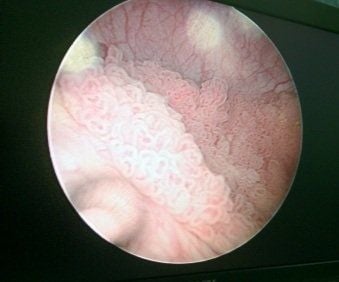This is an automatically translated article.
Malignant bladder tumor or malignant bladder cancer is one of the common cancers in the urinary tract with a poor prognosis if detected late and the disease is already in an advanced stage, invasive tumor. In such cases, treatment of a malignant bladder tumor may require resection and reconstruction of the bladder.
1. Overview of malignant bladder tumor disease
Malignant bladder tumor or bladder cancer is one of the most common types of cancer in the genitourinary system in men, with a very high incidence, only after prostate cancer and prostate cancer. lung cancer and colorectal cancer. Women are also at high risk, but three times lower than men. Malignant bladder cancer is a type of cancer that starts in the bladder, usually from the cells lining the inside of the bladder, with the following types:
Urinary carcinoma, also called is transitional cell cancer: This is the most common type of bladder cancer, tumor cells start from the surface and grow outward. Tumor easily invades and metastasizes to other organs when there is no peduncle. Squamous cell carcinoma: This is a less common malignant bladder cancer that occurs only in patients with bladder parasitic infections or chronically irritated bladder lining. Adenocarcinoma: This type of bladder cancer very rarely metastasizes. Bladder cancer has the potential to recur in the same or different locations in the bladder and has a tendency to metastasize to the liver, lungs, bones, and lymph nodes. Factors that increase the risk of malignant bladder cancer are mainly smoking (in men), abuse of pain relievers, long-term use of cancer drugs, chronic inflammation or infection, often frequently exposed to industrial chemicals (especially textiles, rubber, ...)

Khối u bàng quang ác tính có thể gặp ở cả nam giới và nữ giới
2. Symptoms of Malignant Bladder Tumor
In the early stages, bladder cancer has almost no obvious symptoms, until the advanced stage, the patient will see symptoms such as:
Blood in the urine, frequent urination, pain when urinating: Here This is the primary symptom of bladder cancer. But sometimes the person may feel no pain when urinating. Back pain: This is a manifestation of the disease at an advanced stage, in addition to back pain, the patient also feels bone pain, swollen legs and unable to urinate. Urinary tract infection: Lower back pain, pain around the kidneys is a sign of a urinary tract infection when there is a tumor in the bladder. Anemia, fatigue, weight loss: Bladder cancer patients often have unexplained weight loss, people are always in a state of fatigue, lethargy and are at high risk of anemia.
3. Diagnosis of malignant bladder tumor
Diagnosis of malignant bladder cancer includes the following methods and techniques:
Clinical examination: First, the doctor will perform a clinical examination to check the abdomen and pelvis for tumors. Urinalysis: Cancer cells or any other signs of bladder tumors can also be found through urine testing. Ultrasound: Abdominal ultrasound or endoscopic ultrasound allows to identify the tumor, but the results cannot confirm the diagnosis as well as assess the stage of the disease, the possibility of invasion or spread. Ultrasound techniques may be indicated to evaluate lesions in the upper urinary tract, hydronephrosis, renal parenchymal damage and to distinguish soft tissue lesions from stones. CT or MRI scan: For malignant bladder cancer, a CT scan or MRI of the abdomen and pelvis allows the detection and assessment of the possibility of metastasis, the extent of tumor spread to other organs such as lymph nodes. blood, liver, ... and check how the upper urinary tract is blocked. Contrast pyelogram (UIV): This technique allows assessment of kidney function in cases of suspected tumor invasion of the kidney and ureteral compression, or can also check for chronic urinary tract inflammation. Bone scan: Malignant bladder cancer can invade the bone and cause bone pain. Then bone scintigraphy is indicated. PET-CT scan: This is a high-tech imaging test, applied to evaluate metastasis in cancer diseases. Contrast X-ray: Injecting a contrast agent into a vein and eliminating the drug from the bladder when the X-ray is taken will allow abnormalities in the bladder to be detected. Bladder biopsy: Laparoscopy and biopsy of the bladder are the last techniques to be applied and allow accurate diagnosis of bladder malignancy. This is also the treatment method to remove the entire tumor in cases where the patient has been diagnosed.

Khối u bàng quang ác tính được chẩn đoán bằng cách nội soi và sinh thiết bàng quang
4. Treatment of malignant bladder tumor and prognosis
Early-stage bladder cancer or superficial cancers have a better prognosis, rarely leading to death. But with invasive, advanced, recurrent tumors and squamous cell and adenocarcinoma types with a poorer prognosis, the 5-year survival rate is only 50% because when detected, the disease is already at an advanced stage. progression stage.
There are many methods of treating malignant bladder tumors, depending on each case:
Surgery: Surgery is indicated in the early stages of the disease. It can be surgery to remove the tumor and a small part of the bladder or surgery to remove the entire bladder in cases where the tumor has invaded deep into the bladder wall. Chemotherapy: This method can be used before or after surgery to kill cancer cells. Radiation therapy: Like chemotherapy, radiation therapy may be given before or after surgery to shrink a malignant bladder tumor (before) or destroy any remaining bladder cancer cells. after). Or doctors can also combine treatment with both radiation therapy and chemotherapy. If you see symptoms such as painful urination, urinary frequency, blood in the urine, fatigue, back pain, unexplained weight loss, the patient should see a doctor for a health check, in order to detect cancer early. Malignant bladder cancer for timely treatment.
Currently Vinmec International General Hospital is a general hospital with the function of examining and treating diseases. Accordingly, Vinmec has also performed endoscopic diagnosis, treatment, and cancer screening at an early stage with modern medical methods, which not only brings high efficiency but also minimizes complications. disease recurrence. The great success is because Vinmec is always fully equipped with modern facilities, examination and treatment procedures are performed by a team of experienced and qualified doctors that will bring about treatment results. optimal for customers.
Please dial HOTLINE for more information or register for an appointment HERE. Download MyVinmec app to make appointments faster and to manage your bookings easily.













